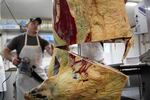
Michael Junkins, general manager of the M. Crow restaurant in Lostine, Oregon, serves a customer on Thursday, Jan. 19, 2023. The workaround to get meat for the restaurant has been a source of frustration for Junkins. “It shouldn’t be this hard," he said, "for a local restaurant to serve meat from here."
Kristian Foden-Vencil / OPB
At the Intermountain Stockyard in La Grande, rancher Todd Nash watches the action as he works to sell four small cows to improve his breed stock and pay for feed. Some of the animals he’s selling today may end up in hamburgers. But in the stockyard’s canteen, he has no idea whether the burger on his plate comes from a local ranch or from New Zealand.
That’s because when cattle enter a U.S. Department of Agriculture-inspected processing plant, they get sorted with animals from elsewhere. The same is true at every step of the process, from shipping to markets.
Each step in that path from farm to shelf adds value. So while Nash might get $1,000 selling one of his large cows to a neighbor, once it’s sent off to get slaughtered, cut, wrapped, frozen and put on a supermarket shelf, the animal’s total worth is more like $5,500.
That means retailers, shippers and processors receive 80% of the cows’ value – and often those companies are large, out of state, organizations.
“That money can be all captured here,” Nash said. “It could benefit our communities, especially those that have lost logging and timber and mill infrastructure.”

Ranchers buy and sell cattle at the Intermountain Livestock Exchange in La Grande, Oregon, on Thursday, Jan. 19, 2023.
Kristian Foden-Vencil / OPB
In practical terms, the current system means that, if Nash or anyone else wants to boost Oregon’s economy by buying local beef, it’s very difficult and requires an expensive work around.
Watching money leave Oregon is hard for Nash – and for regulators. That’s why the Oregon Department of Agriculture has spent $2 million to create a new Oregon meat inspection program – even though the federal government already runs an inspection program. And to process the new state inspected meat, agricultural authorities are trying to increase capacity at Oregon’s small slaughterhouses.
Passage of House Bill 2907 this session would bring in another $10 million for the new program.
Up to now, Oregon has relied on federal meat inspectors with the U.S. Department of Agriculture. But Oregon only has 13 large federal inspected slaughterhouses and 36 counties. So some ranchers have to drive three hours or more, each way, to get their cattle killed and processed.
Todd Nash drives to Nampa, Idaho.
“It’s a full day,” he said. “By the time you load the cattle up, unload them, stop for fuel, you’re 10 hours into it.”

Head of the Oregon Cattlemen's Association, Todd Nash, delivers $300 worth of feed to cattle on his ranch in Wallowa County on Thursday, Jan. 19, 2023. Retailers, shippers and processors receive 80% of a cows’ value – and often those companies are large, out of state, organizations. “That money can be all captured here,” Nash said. “It could benefit our communities, especially those that have lost logging and timber and mill infrastructure.”
Kristian Foden-Vencil, Kristian Foden-Vencil / OPB
The Oregon agriculture department is taking a two-pronged approach to build the new system. The first is training new state meat inspectors. The second involves helping small slaughterhouses grow so they can handle more capacity.
Bill and Kaleen Oldridge run BillyBob’s Butcher Shop and Stafford’s in Union County. Until recently, they processed a maximum of two animals a day, because there were only two of them and they had minimal equipment. Each animal took several hours’ work. That compares to 1,800 animals a day that are processed at a large federally inspected factory slaughterhouse.
Boosting production at BillyBob’s started with a $400,000 grant from the state, which the Oldridges used to buy new equipment, including a more efficient saw, a new smoker, a briner, packer and a grinder.

Bill Oldridge of BillyBob's Butchers in Elgin, stands next to a side of beef on Thursday, Jan. 19, 2023. Oldridge said he numbers each side that goes through his plant so people know exactly where their food comes from.
Kristian Foden-Vencil / OPB
They now process up to 12 animals a day and they’ve hired 10 new employees. The Oldridges are busy putting in all the sanitation and hazard analysis procedures required before they can finally secure a state inspector.
Up to now, each animal to go through BillyBob’s has generally been purchased by a local family from a local rancher. And after the animal is processed, that family is not allowed to sell the meat, because it hasn’t been individually inspected.
Instead, the meat goes to stock the family’s freezer.

Kaleen Oldridge of BillyBob's Butchers in Elgin, said Thursday, Jan. 19, 2023, that she hopes to welcome state meat inspectors into her plant because it'll mean their meat can be sold to local restaurants and stores.
Kristian Foden-Vencil / OPB
People do it because they want to know where their food comes from, explained Kaleen Oldridge.
“They get to know who’s producing it, where it’s being raised, what it’s being fed. There’s no guess,” she said. “There’s no, ‘What did it eat? Where did it eat? Did they give it medications? Did they give it antibiotics? Did they give it hormones, or anything else?’”
She said a state inspector will mean the meat she processes can be sold to local stores and restaurants.
The ODA said it will size the program to serve producers up to five consecutive eight hour days during the basic work week -- Monday to Friday.

People who bring their cattle to be butchered at BillyBob's in Elgin, Oregon, can look at this chart, shown here on Thursday, Jan. 19, 2023, to decide which cuts of meat they'd like.
Kristian Foden-Vencil / OPB
The Oregon Department of Agriculture is working with about 15 Oregon businesses interested in adopting the new inspection program. But it’s taking a while to boost local production and train staff.
“The ODA will staff up the program as needed to accommodate the requests for service,” spokeswoman Andrea Cantu-Schomus said, in a statement.
“This is not a program that will (be) fully operational overnight and will take time to mature as businesses and customers grow.”
By starting its own state inspection program, Oregon regulators hope to turn animal processing into a more local business and to save ranchers time and money — not to mention allowing Oregonians to eat beef from the cattle they see in the fields.

Todd Nash of the Oregon Cattlemen's Association, shown here Thursday, Jan. 19, 2023, on his ranch in Wallowa County, supports the idea of Oregon increasing the size of its small local slaughterhouses.
Kristian Foden-Vencil / OPB
“85% of the cattle that are processed in the United States right now are processed by four large processors,” said Nash, who is also chairman of the Oregon Cattlemen’s Association. “It’s Tyson, Cargill, Marfrig and JBS. And the last two are Brazilian companies. So I think this is a really positive move.”
Small slaughterhouses became more popular during COVID, when workers at several large plants became sick, and meat supplies dwindled.

Workers at BillyBob's Butchers in Elgin, Oregon, cut a side of beef into portions on Thursday, Jan 19, 2023.
Kristian Foden-Vencil / OPB
In the small ranching town of Lostine, many people can’t wait for the new system to come on line.
The owners of the M. Crow restaurant and general store for example, still have to conduct an extensive work-around to serve local beef. They buy cows off local ranchers who make an eight-hour round trip to the nearest USDA inspected plant in Idaho. The restaurant then has a staff member make another eight-hour trip to pick the beef up after it’s been aged and processed.
“It shouldn’t be this hard for a local restaurant to serve meat from here,” said general manager Michael Junkins.

Getting local meat requires an extensive work-around, but every Friday the M. Crow restaurant in Lostine, Oregon, shown here on Thursday, Jan. 19, 2023, serves a burger guaranteed to have been raised in local fields.
Kristian Foden-Vencil / OPB
Union County Commissioner Paul Anderes agrees. He goes through the same arduous process to sell the goat meat raised by his kids in 4-H. He sees a parallel with Oregon’s 1980s craft beer movement.
“There weren’t rules, and they were trying to figure how these small breweries could do it,” he said.
He’s not sure the new system will make meat cheaper. But that’s not really the point: “You’re looking for a quality, unique product that the consumer is really demanding now.”
Some people worry the new state system might not be as safe as the federal system. But supporters point out the new Oregon program will hold meat processors to the same health standards.
“The state meat inspection program is not meant to compete with USDA,” Cantu-Schomus said. “Instead it complements the federal program.”

Union County Commissioner Paul Anderes, shown here on Monday, Jan. 23, 2023, in LaGrande, Oregon, goes through an arduous process to sell the goat meat raised by his kids in 4-H. He sees a parallel with Oregon’s 1980s craft beer movement, “There weren’t rules, and they were trying to figure how these small breweries could do it,” he said.
Kristian Foden-Vencil / OPB
